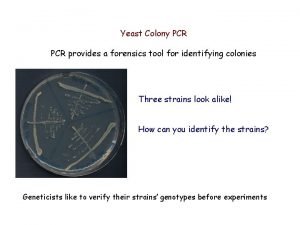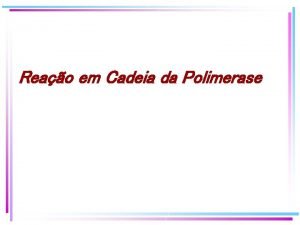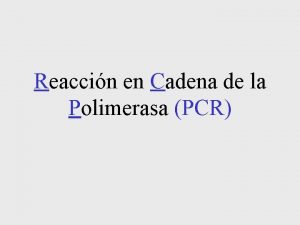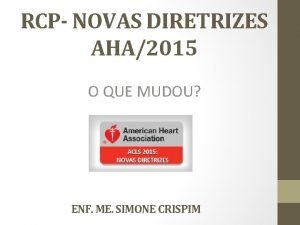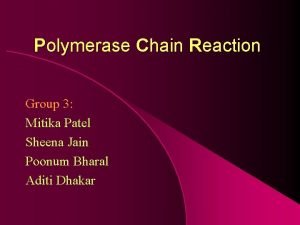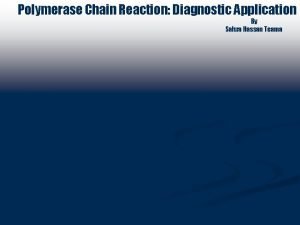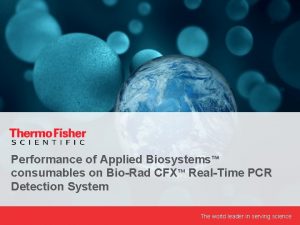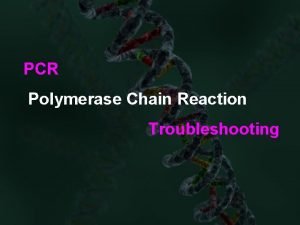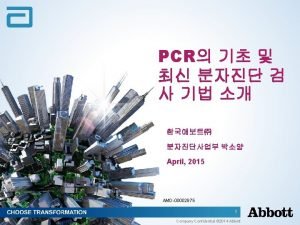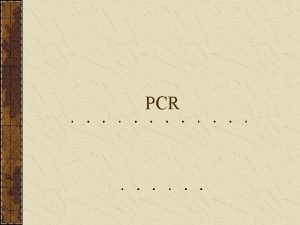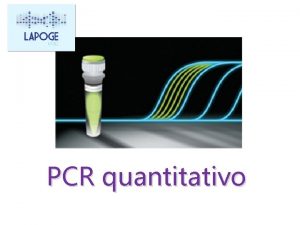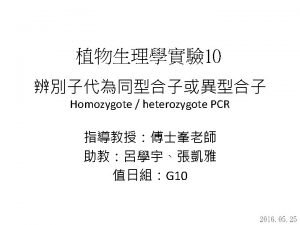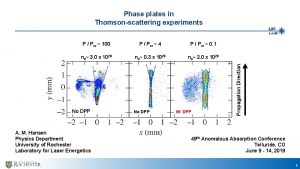PCR 94 How does PCR work work Separation









- Slides: 9

PCR 94° • How does PCR work? : work? • Separation of two strands from each other (94 o. C) • Annealing of Primers (55 o. C) • Beginning of Replication • Extension (polymerisastion) (72 o. C) • = replication • Repeat for 20 -30 times (cycles) 72° 55°

CYCLE PARAMETRES Denaturation; 93°C - 95°C 30 sec – 1 min Annealing; 37°C - 65°C 30 sec – 1 min Extension; 72°C 1 min (For every 500 bp DNA add + 30 sec) 25 -35 cycles Final exstantion 2 -10 min

Basic PCR conditions • 25 -50 -100 µl final reaction volumes • Template DNA 1 -1000 ng • Primers 10 -20 pmols • 10 m. M Tris-CL p. H 9. 0, 50 m. M KCl (10 x. PCR buffer) • Mg. Cl 2 0. 5 -3. 0 m. M • final concentration of each dn. TPs would be 200 µM d. NTP’ler: d. ATP, d. GTP, d. TTP, d. CTP • 1 unit Taq polymerase enzyme

REACTION MIXTURE 25 or 50 l final volume Eppendorf (0. 2 ml) tube COntents Volumes Final Concentration 10 X PCR Buffer 5 l 1 X 10 X d. NTPs (2 m. M) 5 l 200 M Forward primer (10 pmols/ l) 5 l 1 M (50 pmols/50 l) Reverse primer (10 pmols/ l) 5 l 1 M (50 pmols/50 l) Genomic DNA template 2 l 1 g Taq polymerase (2 U/ l) 0. 5 l 1 unit H 2 O (to 50 l Final volume) 27. 5 l

3. Cycle is the first cycle when the first products of targeted length From this cycle on amplication proceeds exponentially Amplimers synthesized according to equation mentioned below: After n number of PCR cycles where exponential amplification No(1+Y)n-1 target copy will be formed! No Y n starting number of DNA targets Efficiency of PCR reaction cycle number

Lets presume that only 1 DNA target exists • • 4. cycle 1(1+1)3=8 No(1+Y)n-1 5. cycle 1(1+1)4=16 6. cycle 1(1+1)5=32 After a definite number of cycles PCR efficiency decreases.

ALWAYS SHOULD BE REMEMBERED! PCR is a very sensitive technique– DNA contamination with an unwanted DNA could be significant! Always add negative controls to the reaction! Always add positive controls to the reaction! Use appropriate filtered pipets and pippet tipds Perform PCR in separate units Use laminar flows with UV lambs

PCR is used for; • Cloning of gene or gene fragments • Genetic diagnosis – Detection mutations • Maternity-Paternity Tests • DNA sequence analysis • Forensic identification • Determination of quality control of industrial products • Determination of transplantation appropriate tissue type for • Determination of polymorphism in between species • Molecular typing • Detection of pathogens tissue

Advantages and Disadvantages of PCR! • High sensitivity and specificity! • Fast detection and identification! • Could detect inanimate (dead) agents! • Could detect acid-fast and environment fragile agents! • Could detect slow growing bacteria • Provide the probability of later sophisticated studies (typing, sequence analysis, clonning) olanak sağlaması • Still cannot replace isolation in definitive diagnosis! • False-positiveness due to cross-contamination! • Requires lab infrastructure! • Requires well trained personnel! • High expendature costs!


